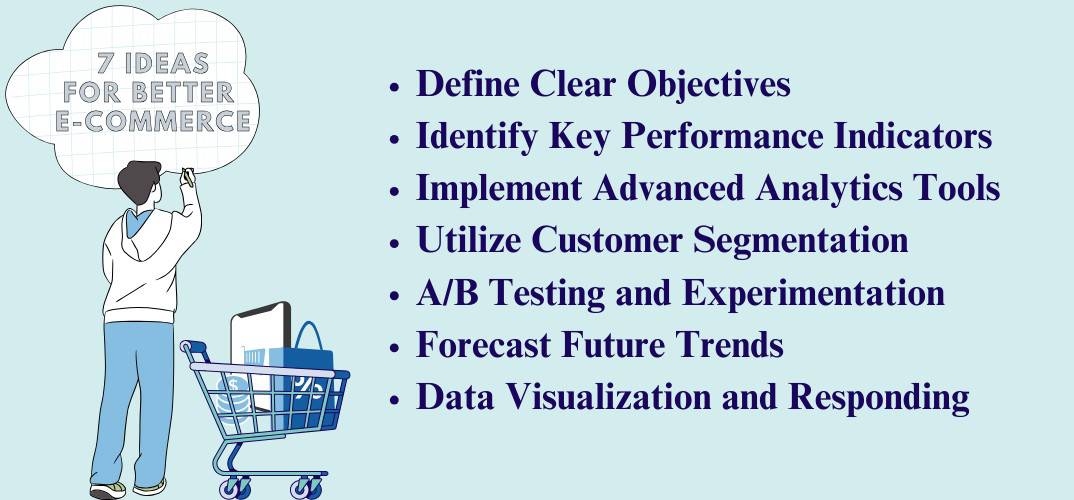Are you someone who owns an e-commerce website or planning to own one in the future? Then, you need to gain better understanding in rightly marketing your online store, designing your website to attract your target customers and then ensuring enough conversion to bring you profit.
Without such an understanding, you may end up feeling frustated and overwhelmed.
Owning a business means you need to focus on many things at once. And all these elements of business, like marketing, inventory, sales, customer service require your attention. One thing that will ensure every thing is taken into account is e-commerce analytics.
What is E-commerce Analytics?
E-commerce analytics is the process of gathering data from all areas that are affecting your online store and then using this data to understand the trends in client behavior. Making decisions based on this data will eventually result in more online sales and thereby your success. So say yes to e-commerce analytics!
Using the best strategies and marketing techniques after analyzing the data will bring you more online sales. The data you obtain will be raw and making intelligent decisions using them will be difficult. That is where analytics tools come in handy.
How to Use it for Your Gain?
By now, you must have understood the importance of e-commerce analytics. And if you are wondering how to use e-commerce analytics in a way that will benefit you, then you have reached the right place. Let’s explore the ways you can use analytics and data collected for the success of your website.

1. Define Clear Objectives
What do you seek to achieve through analytics? Is it higher conversion rates, fortified customer loyalty, or optimized inventory management?
By setting clear objectives, you not only instill your analytics efforts with purpose but also ensure that every data point you scrutinize serves a specific goal.
2. Identify Key Performance Indicators
E-commerce analytics thrive when anchored in the right Key Performance Indicators (KPIs). As the name suggests, they are indicators of the performance of your business. Common e-commerce KPIs include:
- Conversion Rate: The percentage of visitors who complete a desired action, such as making a purchase.
- Average Order Value (AOV): The average amount customers spend per transaction.
- Customer Acquisition Cost (CAC): The cost associated with acquiring a new customer.
- Customer Lifetime Value (CLV): The total revenue a customer generates over their entire relationship with your brand.
Select KPIs that resonate with your business objectives and keep them at the forefront of your analytics efforts!
3. Implement Advanced Analytics Tools
In the modern age of e-commerce, advanced analytics tools are a must. Consider investing in tools like Google Analytics, Adobe Analytics, or e-commerce-specific platforms such as Shopify’s analytics. These tools offer capabilities like funnel analysis, cohort analysis, and attribution modeling, empowering you to navigate uncharted waters with confidence.
Finding the right e-commerce tool will help you gain an immeasurable advantage in the competitive business world. And with the right analytics tool, you can future-proof your business and ensure your e-commerce success.
4. Utilize Customer Segmentation
E-commerce is not a one-size-fits-all endeavor; it’s a personalized journey for each customer.
Leverage e-commerce analytics to segment your customer base based on various criteria, including demographics, purchase history, browsing behavior, and geographic location. Customer segmentation enables you to tailor your marketing efforts, content, and promotions to specific groups, enhancing the overall customer experience and increasing conversion rates.
5. A/B Testing and Experimentation
A/B Testing is one of a kind experimentation test in which two different versions of a website or a webpage element is shown to different segments of website visitors to find out which versions works better compared to the other one.
Implement A/B testing to compare different versions of web pages, email campaigns, or advertisements. Test variables like headlines, images, call-to-action (CTA) buttons, and pricing strategies to discover what resonates best with your audience. Continuously refine your strategies based on the results of these experiments.
6. Forecast Future Trends
Imagine getting the ability to foresee the future of your e-commerce business. With predictive and prescriptive analytics, this is now a reality.
You can implement predictive models to anticipate customer behavior, predict demand for products, and offer personalized product recommendations. This proactive approach allows you to stay one step ahead of your customers’ needs and preferences.
With prescriptive analytics, you get suggestions to achieve your desired goal. It can be used to find the optimal price, promotion, or marketing channel for a product.
7. Data Visualization and Responding
The true power of data lies not just in its collection but also in its interpretation.
Data visualization tools, such as interactive dashboards and reports, give you greater insights into what’s happening.
Create visually appealing and user-friendly dashboards that provide real-time insights into your e-commerce performance. Tools like Tableau, Power BI, or Google Data Studio can help you transform raw data into captivating, actionable insights that are not only easy to understand but also a joy to share.
Benefits of E-commerce Analytics
E-commerce analytics matters!
It empowers businesses with the knowledge and tools needed to thrive in a competitive online marketplace. It leads to smarter decisions, improved customer experiences, efficient operations, and a stronger position in the e-commerce landscape.
It’s not just a luxury; it’s a necessity for any e-commerce business looking to succeed and grow.
In a Nutshell
With the right strategy and consistent effort, your e-commerce website can stand tall among all the competition it faces. Backup your efforts with the right information and statistics to ensure the best results.
By defining clear objectives, selecting the right KPIs, investing in advanced analytics tools, utilizing customer segmentation, conducting A/B testing, leveraging predictive analytics, and employing data visualization, you can unlock the full potential of e-commerce analytics.
